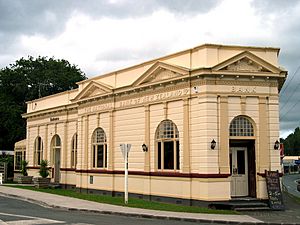Paparoa facts for kids
Quick facts for kids
Paparoa
|
|
|---|---|

Former National Bank of New Zealand, Paparoa, Northland (now a private residence) Listed Heritage 1 status
|
|
| Country | New Zealand |
| Region | Northland Region |
| District | Kaipara District |
| Ward | Otamatea Ward |
| Electorates |
|
| Area | |
| • Total | 8.74 km2 (3.37 sq mi) |
| Population
(June 2023)
|
|
| • Total | 400 |
| • Density | 46/km2 (119/sq mi) |
Paparoa is a small town in the Northland area of New Zealand. A stream called Paparoa Stream flows through the town. It then joins the Paparoa Creek, which leads to the Arapaoa River. This river is part of the large Kaipara Harbour.
State Highway 12, a main road, goes right through Paparoa. The town of Matakohe is about 6 km to the southwest. Maungaturoto is about 12 km to the east. The New Zealand Ministry for Culture and Heritage says that the name Paparoa means "long flats".
Contents
History of Paparoa
Early European Settlement
Paparoa was one of several towns in the Kaipara area started by a religious group called the Albertlanders. They were settlers who came from England in the 1860s. Their main settlement was Port Albert near Wellsford.
The Albertlanders arrived in the Paparoa area in 1863. They cleared the land by burning it. This made space for planting crops like corn and grass for animals.
Developing the Town
In 1865, a road was built to the port at Pahi. Soon after, another road connected Paparoa to Matakohe. In the 1870s, Paparoa had a pottery factory that used local clay. There was also a factory that made rope and mats from flax.
Brick and tile yards were also set up. However, these businesses faced challenges. The roads were poor, and it cost a lot to transport goods. The closest shops were in Pahi, about 6 miles (10 km) away.
Transport and Growth
From 1882, a steamboat called the Minnie Casey offered a weekly service. It connected Paparoa with Helensville, on the south side of the Kaipara Harbour. Later, from 1891 to 1895, the S.S. Ethel took over this service. After that, boats only went to Matakohe and Pahi.
During the 1880s and 1890s, the roads in the area got much better. By the 1890s, Paparoa had about 35 families and 200 people. Most of them lived along the Paparoa River. If you included Pahi, there were about 400 people in the wider area.
By 1906, the population of Paparoa had doubled. Farming, especially raising animals, became very important. A dairy factory opened in Paparoa in January 1895. A branch of a department store from Helensville also opened in the town in the early 1900s.
20th Century Changes
In the early 1920s, the North Auckland railway line reached Huarau, which is east of Paparoa. There were plans to build the railway through Paparoa, but this never happened. In 1922, the road to Maungaturoto, which goes through Huarau, was paved.
Marae and Culture
The local Ōtamatea marae is an important meeting place for the Ngāti Whātua and Te Uri o Hau tribes. A marae is a special place for Māori people to gather for important events. The Aotearoa wharenui is the main meeting house on the marae.
Paparoa's Population
Paparoa is a rural town. It covers an area of about 8.74 square kilometers. In the 2023 New Zealand census, Paparoa had a population of 417 people. This was an increase of 54 people since the 2018 census. It also showed an increase of 87 people since the 2013 census.
There were slightly more males (207) than females (201) in the town. The average age of people in Paparoa was 44.2 years. About 19.4% of the people were under 15 years old. Around 23.7% were 65 years or older.
Most people in Paparoa (87.8%) are of European background (called Pākehā). About 15.8% are Māori. Most people (97.8%) speak English.
Notable People from Paparoa
Some well-known people have connections to Paparoa:
- Alex Tait, a cricketer, was born in Paparoa.
- James Wright, a potter, worked in Paparoa in the mid-1870s.
- Lockwood Smith, a politician, was born in Paparoa.
- Sam Hunt, a famous poet, lives in Paparoa.
Education in Paparoa
Paparoa School is a school for both boys and girls. It teaches students from Year 1 to Year 6. As of 2023, the school has about 100 students.
The school first opened in 1870. In its early years, up to 1899, it had between 27 and 42 students.

